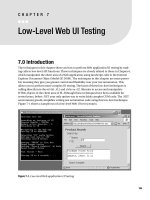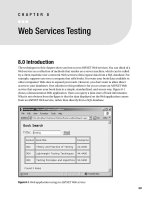09 python web penetration testing cookbook
Bạn đang xem bản rút gọn của tài liệu. Xem và tải ngay bản đầy đủ của tài liệu tại đây (1.76 MB, 224 trang )
1
1
www.it-ebooks.info
Python Web Penetration
Testing Cookbook
Over 60 indispensable Python recipes to ensure
you always have the right code on hand for web
application testing
Cameron Buchanan
Terry Ip
Andrew Mabbitt
Benjamin May
Dave Mound
BIRMINGHAM - MUMBAI
www.it-ebooks.info
Python Web Penetration Testing Cookbook
Copyright © 2015 Packt Publishing
All rights reserved. No part of this book may be reproduced, stored in a retrieval system, or
transmitted in any form or by any means, without the prior written permission of the publisher,
except in the case of brief quotations embedded in critical articles or reviews.
Every effort has been made in the preparation of this book to ensure the accuracy of the
information presented. However, the information contained in this book is sold without
warranty, either express or implied. Neither the authors, nor Packt Publishing, and its dealers
and distributors will be held liable for any damages caused or alleged to be caused directly or
indirectly by this book.
Packt Publishing has endeavored to provide trademark information about all of the companies
and products mentioned in this book by the appropriate use of capitals. However, Packt
Publishing cannot guarantee the accuracy of this information.
First published: June 2015
Production reference: 1180615
Published by Packt Publishing Ltd.
Livery Place
35 Livery Street
Birmingham B3 2PB, UK.
ISBN 978-1-78439-293-2
www.packtpub.com
www.it-ebooks.info
Credits
Authors
Copy Editors
Cameron Buchanan
Ameesha Green
Terry Ip
Rashmi Sawant
Andrew Mabbitt
Sameen Siddiqui
Benjamin May
Project Coordinator
Dave Mound
Kinjal Bari
Reviewers
Proofreader
Sam Brown
Safis Editing
James Burns
Rejah Rehim
Indexer
Ishbir Singh
Hemangini Bari
Matt Watkins
Graphics
Commissioning Editor
Sarah Crofton
Disha Haria
Acquisition Editor
Production Coordinator
Sam Wood
Nitesh Thakur
Content Development Editor
Riddhi Tuljapur
Sheetal Aute
Cover Work
Nitesh Thakur
Technical Editor
Saurabh Malhotra
www.it-ebooks.info
About the Authors
Cameron Buchanan is a penetration tester by trade and a writer in his spare time. He has
performed penetration tests around the world for a variety of clients across many industries.
Previously, he was a member of the RAF. In his spare time, he enjoys doing stupid things, such
as trying to make things fly, getting electrocuted, and dunking himself in freezing cold water.
He is married and lives in London.
Terry Ip is a security consultant. After nearly a decade of learning how to support IT
infrastructure, he decided that it would be much more fun learning how to break it
instead. He is married and lives in Buckinghamshire, where he tends to his chickens.
Andrew Mabbitt is a penetration tester living in London, UK. He spends his time beating
down networks, mentoring, and helping newbies break into the industry. In his free time, he
loves to travel, break things, and master the art of sarcasm.
Benjamin May is a security test engineer from Cambridge. He studied computing
for business at Aston University. With a background in software testing, he recently
combined this with his passion for security to create a new role in his current company.
He has a broad interest in security across all aspects of the technology field, from reverse
engineering embedded devices to hacking with Python and participating in CTFs. He is a
husband and a father.
www.it-ebooks.info
Dave Mound is a security consultant. He is a Microsoft Certified Application Developer
but spends more time developing Python programs these days. He has been studying
information security since 1994 and holds the following qualifications: C|EH, SSCP, and
MCAD. He recently studied for OSCP certification but is still to appear for the exam. He enjoys
talking and presenting and is keen to pass on his skills to other members of the cyber
security community.
When not attached to a keyboard, he can be found tinkering with his 1978 Chevrolet Camaro.
He once wrestled a bear and was declared the winner by omoplata.
This book has been made possible through the benevolence and expertise
of the Whitehatters Academy.
www.it-ebooks.info
About the Reviewers
Sam Brown is a security researcher based in the UK and has a background in software
engineering and electronics. He is primarily interested in breaking things, building tools to
help break things, and burning himself with a soldering iron.
James Burns is currently a security consultant, but with a technology career spanning over
15 years, he has held positions ranging from a helpdesk phone answerer to a network cable
untangler, to technical architect roles. A network monkey at heart, he is happiest when he is
up to his elbows in packets but has been known to turn his hand to most technical disciplines.
When not working as a penetration tester, he has a varied range of other security interests,
including scripting, vulnerability research, and intelligence gathering. He also has a long-time
interest in building and researching embedded Linux systems. While he's not very good at
them, he also enjoys the occasional CTF with friends. Occasionally, he gets out into the real
world and pursues his other hobby of cycling.
I would like to thank my parents for giving me the passion to learn and the
means to try. I would also like to thank my fantastic girlfriend, Claire, for
winking at me once; never before has a wink led to such a dramatic move.
She continues to support me in all that I do, even at her own expense.
Finally, I should like to thank the youngest people in my household, Grace
and Samuel, for providing me with the ultimate incentive for always trying to
improve myself. These are the greatest joys that a bloke could wish for.
www.it-ebooks.info
Rejah Rehim is currently a software engineer for Digital Brand Group (DBG), India and is a
long-time preacher of open source. He is a steady contributor to the Mozilla Foundation and
his name has featured in the San Francisco Monument made by the Mozilla Foundation.
He is part of the Mozilla Add-on Review Board and has contributed to the development of
several node modules. He has also been credited with the creation of eight Mozilla add-ons,
including the highly successful Clear Console add-on, which was selected as one of the best
Mozilla add-ons of 2013. With a user base of more than 44,000, it has registered more
than 4,50,000 downloads till date. He successfully created the world's first one-of-the-kind
Security Testing Browser Bundle, PenQ, which is an open source Linux-based penetration
testing browser bundle, preconfigured with tools for spidering, advanced web searching,
fingerprinting, and so on.
He is also an active member of the OWASP and the chapter leader of OWASP, Kerala.
He is also one of the moderators of the OWASP Google+ group and an active speaker at
Coffee@DBG, one of the premier monthly tech rendezvous in Technopark, Kerala. Besides
currently being a part of the Cyber Security division of DBG and QBurst in previous years,
he is also a fan of process automation and has implemented it in DBG.
Ishbir Singh is studying computer engineering and computer science at the Georgia
Institute of Technology. He's been programming since he was 9 and has built a wide variety
of software, from those meant to run on a calculator to those intended for deployment in
multiple data centers around the world. Trained as a Microsoft Certified System Engineer
and certified by Linux Professional Institute, he has also dabbled in reverse engineering,
information security, hardware programming, and web development. His current interests lie
in developing cryptographic peer-to-peer trustless systems, polishing his penetration testing
skills, learning new languages (both human and computer), and playing table tennis.
www.it-ebooks.info
Matt Watkins is a final year computer networks and cyber security student. He has been
the Cyber Security Challenge master class finalist twice. Most of the time, you'll find him
studying, reading, writing, programming, or just generally breaking things. He also enjoys
getting his heart pumping, which includes activities such as running, hitting the gym, rock
climbing, and snowboarding.
www.it-ebooks.info
www.PacktPub.com
Support files, eBooks, discount offers, and more
For support files and downloads related to your book, please visit www.PacktPub.com.
Did you know that Packt offers eBook versions of every book published, with PDF and ePub
files available? You can upgrade to the eBook version at www.PacktPub.com and as a print
book customer, you are entitled to a discount on the eBook copy. Get in touch with us at
for more details.
At www.PacktPub.com, you can also read a collection of free technical articles, sign up
for a range of free newsletters and receive exclusive discounts and offers on Packt books
and eBooks.
TM
/>
Do you need instant solutions to your IT questions? PacktLib is Packt's online digital book
library. Here, you can search, access, and read Packt's entire library of books.
Why subscribe?
ff
Fully searchable across every book published by Packt
ff
Copy and paste, print, and bookmark content
ff
On demand and accessible via a web browser
Free access for Packt account holders
If you have an account with Packt at www.PacktPub.com, you can use this to access
PacktLib today and view 9 entirely free books. Simply use your login credentials for
immediate access.
www.it-ebooks.info
www.it-ebooks.info
Disclamer
This book contains details on how to perform attacks against web
applications using Python scripts. In many circumstances, these attacks
are likely to be illegal in your jurisdiction and can be considered terms
of service violation and/or professional misconduct. The instructions
in this book are provided for usage in the context of formal penetration
tests to protect a system against attacks, which are conducted with the
permission of a site owner.
www.it-ebooks.info
www.it-ebooks.info
Table of Contents
Prefacev
Chapter 1: Gathering Open Source Intelligence
1
Introduction1
Gathering information using the Shodan API
2
Scripting a Google+ API search
7
Downloading profile pictures using the Google+ API
9
Harvesting additional results from the Google+ API using pagination
10
Getting screenshots of websites with QtWebKit
12
Screenshots based on a port list
15
Spidering websites
19
Chapter 2: Enumeration
23
Chapter 3: Vulnerability Identification
47
Introduction23
Performing a ping sweep with Scapy
24
Scanning with Scapy
28
Checking username validity
30
Brute forcing usernames
32
Enumerating files
34
Brute forcing passwords
36
Generating e-mail addresses from names
39
Finding e-mail addresses from web pages
41
Finding comments in source code
43
Introduction47
Automated URL-based Directory Traversal
48
Automated URL-based Cross-site scripting
51
Automated parameter-based Cross-site scripting
52
Automated fuzzing
58
jQuery checking
61
i
www.it-ebooks.info
Table of Contents
Header-based Cross-site scripting
Shellshock checking
64
68
Chapter 4: SQL Injection
71
Chapter 5: Web Header Manipulation
87
Introduction71
Checking jitter
71
Identifying URL-based SQLi
73
Exploiting Boolean SQLi
76
Exploiting Blind SQL Injection
79
Encoding payloads
83
Introduction87
Testing HTTP methods
88
Fingerprinting servers through HTTP headers
90
Testing for insecure headers
92
Brute forcing login through the Authorization header
95
Testing for clickjacking vulnerabilities
97
Identifying alternative sites by spoofing user agents
101
Testing for insecure cookie flags
104
Session fixation through a cookie injection
107
Chapter 6: Image Analysis and Manipulation
109
Chapter 7: Encryption and Encoding
135
Introduction
Hiding a message using LSB steganography
Extracting messages hidden in LSB
Hiding text in images
Extracting text from images
Enabling command and control using steganography
109
110
114
115
119
126
Introduction136
Generating an MD5 hash
136
Generating an SHA 1/128/256 hash
137
Implementing SHA and MD5 hashes together
139
Implementing SHA in a real-world scenario
141
Generating a Bcrypt hash
144
Cracking an MD5 hash
146
Encoding with Base64
148
Encoding with ROT13
149
Cracking a substitution cipher
150
Cracking the Atbash cipher
153
Attacking one-time pad reuse
154
ii
www.it-ebooks.info
Table of Contents
Predicting a linear congruential generator
Identifying hashes
156
158
Chapter 8: Payloads and Shells
165
Chapter 9: Reporting
181
Index
195
Introduction165
Extracting data through HTTP requests
165
Creating an HTTP C2
167
Creating an FTP C2
171
Creating an Twitter C2
174
Creating a simple Netcat shell
177
Introduction181
Converting Nmap XML to CSV
182
Extracting links from a URL to Maltego
183
Extracting e-mails to Maltego
186
Parsing Sslscan into CSV
188
Generating graphs using plot.ly
189
iii
www.it-ebooks.info
www.it-ebooks.info
Preface
Welcome to our book on Python and web application testing. Penetration testing is a massive
field and the realms of Python are even bigger. We hope that our little book can help you
make these enormous fields a little more manageable. If you're a Python guru, you can look
for ideas to apply your craft to penetration testing, or if you are a newbie Pythonist with some
penetration testing chops, then you're in luck, this book is also for you.
What this book covers
Chapter 1, Gathering Open Source Intelligence, covers a set of recipes for collecting information
from freely available sources.
Chapter 2, Enumeration, guides you through creating scripts to retrieve the target information
from websites and validating potential credentials.
Chapter 3, Vulnerability Identification, covers recipes based on identifying potential
vulnerabilities on websites, such as Cross-site scripting, SQL Injection, and outdated plugins.
Chapter 4, SQL Injection, covers how to create scripts that target everyone's favorite web
application vulnerability.
Chapter 5, Web Header Manipulation, covers scripts that focus specifically on the collection,
control, and alteration of headers on web applications.
Chapter 6, Image Analysis and Manipulation, covers recipes designed to identify, reverse,
and replicate steganography in images.
Chapter 7, Encryption and Encoding, covers scripts that dip their toes into the massive lake
that is encryption.
v
www.it-ebooks.info
Preface
Chapter 8, Payloads and Shells, covers a small set of proof of concept C2 channels,
basic post-exploitation scripts, and on server enumeration tools.
Chapter 9, Reporting, covers scripts that focus to make the reporting of vulnerabilities easier
and a less painful process.
What you need for this book
You will need a laptop, Python 2.7, an Internet connection for most recipes and a good sense
of humor.
Who this book is for
This book is for testers looking for quick access to powerful, modern tools and customizable
scripts to kick-start the creation of their own Python web penetration testing toolbox.
Sections
In this book, you will find several headings that appear frequently (Getting ready, How to do it,
How it works, There's more, and See also).
To give clear instructions on how to complete a recipe, we use these sections as follows:
Getting ready
This section tells you what to expect in the recipe, and describes how to set up any
software or any preliminary settings required for the recipe.
How to do it…
This section contains the steps required to follow the recipe.
How it works…
This section usually consists of a detailed explanation of what happened in the
previous section.
There's more…
This section consists of additional information about the recipe in order to make the reader
more knowledgeable about the recipe.
vi
www.it-ebooks.info
Preface
See also
This section provides helpful links to other useful information for the recipe.
Conventions
In this book, you will find a number of text styles that distinguish between different kinds of
information. Here are some examples of these styles and an explanation of their meaning.
Code words in text, database table names, folder names, filenames, file extensions,
pathnames, dummy URLs, user input, and Twitter handles are shown as follows: "first it sends
the HTTP GET request to the API server, then it reads in the response and stores the output
into an api_response variable."
A block of code is set as follows:
import urllib2
import json
GOOGLE_API_KEY = "{Insert your Google API key}"
target = "packtpub.com"
api_response =
urllib2.urlopen(" />query="+target+"&key="+GOOGLE_API_KEY).read()
json_response = json.loads(api_response)
for result in json_response['items']:
name = result['displayName']
print name
image = result['image']['url'].split('?')[0]
f = open(name+'.jpg','wb+')
f.write(urllib2.urlopen(image).read())
f.close()
When we wish to draw your attention to a particular part of a code block, the relevant lines or
items are set in highlighted:
a = str((A * int(str(i)+'00') + C) % 2**M)
if a[-2:] == "47":
Any command-line input or output is written as follows:
$ pip install plotly
Query failed: ERROR: syntax error at or near
vii
www.it-ebooks.info
Preface
New terms and important words are shown in bold. Words that you see on the screen,
for example, in menus or dialog boxes, appear in the text like this: "Click on API & auth |
Credentials. Click on Create new key and Server key."
Warnings or important notes appear in a box like this.
Tips and tricks appear like this.
Reader feedback
Feedback from our readers is always welcome. Let us know what you think about this
book—what you liked or disliked. Reader feedback is important for us as it helps us
develop titles that you will really get the most out of.
To send us general feedback, simply e-mail , and mention the
book's title in the subject of your message.
If there is a topic that you have expertise in and you are interested in either writing or
contributing to a book, see our author guide at www.packtpub.com/authors.
Customer support
Now that you are the proud owner of a Packt book, we have a number of things to help you to
get the most from your purchase.
Downloading the example code
You can download the example code files from your account at
for all the Packt Publishing books you have purchased. If you purchased this book elsewhere,
you can visit and register to have the files e-mailed
directly to you.
viii
www.it-ebooks.info
Preface
Errata
Although we have taken every care to ensure the accuracy of our content, mistakes do happen.
If you find a mistake in one of our books—maybe a mistake in the text or the code—we would be
grateful if you could report this to us. By doing so, you can save other readers from frustration
and help us improve subsequent versions of this book. If you find any errata, please report them
by visiting selecting your book, clicking on
the Errata Submission Form link, and entering the details of your errata. Once your errata are
verified, your submission will be accepted and the errata will be uploaded to our website or
added to any list of existing errata under the Errata section of that title.
To view the previously submitted errata, go to />content/support and enter the name of the book in the search field. The required
information will appear under the Errata section.
Piracy
Piracy of copyrighted material on the Internet is an ongoing problem across all media.
At Packt, we take the protection of our copyright and licenses very seriously. If you come
across any illegal copies of our works in any form on the Internet, please provide us with
the location address or website name immediately so that we can pursue a remedy.
Please contact us at with a link to the suspected
pirated material.
We appreciate your help in protecting our authors and our ability to bring you
valuable content.
Questions
If you have a problem with any aspect of this book, you can contact us at
, and we will do our best to address the problem.
ix
www.it-ebooks.info
www.it-ebooks.info
1
Gathering Open Source
Intelligence
In this chapter, we will cover the following topics:
ff
Gathering information using the Shodan API
ff
Scripting a Google+ API search
ff
Downloading profile pictures using the Google+ API
ff
Harvesting additional results using the Google+ API pagination
ff
Getting screenshots of websites using QtWebKit
ff
Screenshots based on port lists
ff
Spidering websites
Introduction
Open Source Intelligence (OSINT) is the process of gathering information from Open (overt)
sources. When it comes to testing a web application, that might seem a strange thing to do.
However, a great deal of information can be learned about a particular website before even
touching it. You might be able to find out what server-side language the website is written in,
the underpinning framework, or even its credentials. Learning to use APIs and scripting these
tasks can make the bulk of the gathering phase a lot easier.
In this chapter, we will look at a few of the ways we can use Python to leverage the power of
APIs to gain insight into our target.
1
www.it-ebooks.info
Gathering Open Source Intelligence
Gathering information using the Shodan API
Shodan is essentially a vulnerability search engine. By providing it with a name, an IP address,
or even a port, it returns all the systems in its databases that match. This makes it one of
the most effective sources for intelligence when it comes to infrastructure. It's like Google for
internet-connected devices. Shodan constantly scans the Internet and saves the results into
a public database. Whilst this database is searchable from the Shodan website (https://
www.shodan.io), the results and services reported on are limited, unless you access it
through the Application Programming Interface (API).
Our task for this section will be to gain information about the Packt Publishing website by
using the Shodan API.
Getting ready
At the time of writing this, Shodan membership is $49, and this is needed to get an API key.
If you're serious about security, access to Shodan is invaluable.
If you don't already have an API key for Shodan, visit www.shodan.io/store/member
and sign up for it. Shodan has a really nice Python library, which is also well documented at
/>To get your Python environment set up to work with Shodan, all you need to do is simply
install the library using cheeseshop:
$ easy_install shodan
How to do it…
Here's the script that we are going to use for this task:
import shodan
import requests
SHODAN_API_KEY = "{Insert your Shodan API key}"
api = shodan.Shodan(SHODAN_API_KEY)
target = 'www.packtpub.com'
dnsResolve = ' +
target + '&key=' + SHODAN_API_KEY
2
www.it-ebooks.info









